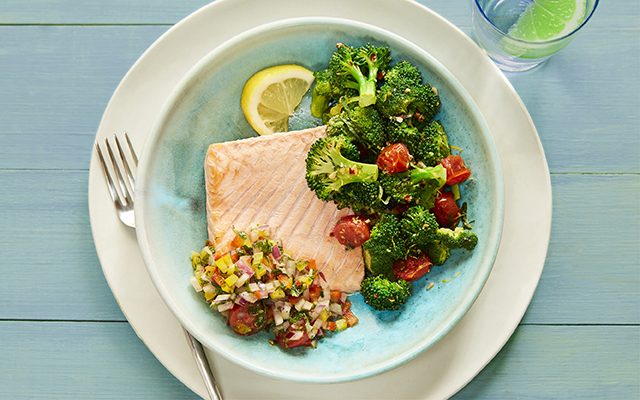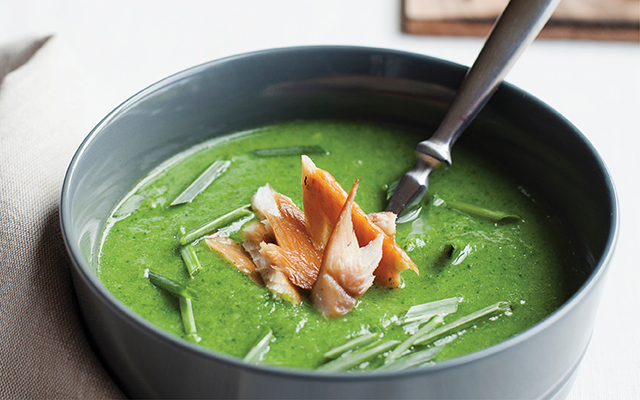Whoever told you to “eat your broccoli” had your best interests in mind. Broccoli is filled with disease-fighting nutrients. And when cooked properly — or creatively prepared raw — it’s scrumptious, too.
Food Basics
Broccoli originated in Italy, and like turnips, kohlrabi, cabbage, Brussels sprouts, kale, collard greens and cauliflower, it is a cruciferous vegetable, or brassica. Its edible parts include the leaves, crunchy stems and soft clusters of tiny green flower buds called florets. When purchasing, select broccoli with tightly closed buds, crisp leaves, and a deep emerald color or purplish tinge. When cooked, broccoli may release sulfur compounds, creating an unpleasant smell but leaving flavor unaffected.
Nutritional Know-How
Broccoli contains sulforaphane, a phytonutrient that helps the body’s detoxification enzymes eliminate abnormal cells, slow tumor growth and reduce the risk of developing intestinal polyps (which usually precede colon cancer). It also helps support healthy functioning (think toxin-filtering) of the liver. Other nutrients in broccoli help the body repair sun-damaged skin, reduce the risk of heart disease and cataracts, prevent or delay osteoporosis, support the immune system, reduce the risk of birth defects, and fight prostate, ovarian and bladder cancer.
One 3⁄4-cup serving of steamed broccoli contains more vitamin C than a typical orange, and it’s also high in vitamins K and A and calcium. Broccoli boasts numerous anti-inflammatory properties, and its dark-green leaves are rich in beta-carotene.
Eat Up!
Boiling broccoli can cause significant nutrient loss, and it rarely produces optimal flavor. If eating it raw doesn’t appeal to you, you can lightly steam or sauté it, or roast it (often the best-tasting option). When cooked, broccoli should maintain its bright green color (pale green broccoli is a sign that it has been overcooked).
- To roast broccoli, first lightly toss florets and small, evenly cut stalks in extra-virgin olive oil. Season with sea salt, and slivered or minced garlic. In a 475-degree F oven, roast for three to five minutes, then turn over and roast an additional three minutes until slightly browned at the edges.
- Add broccoli florets and peeled, chopped stalks to stir-fries. To cook, combine 2 cups broccoli florets and/or chopped or long sliced stalks with a small amount of oil (1 tablespoon of olive or sesame) and sauté for two or three minutes, then add a small amount of broth or water, cover the pan, and let steam until crisp and tender (about two minutes).
- To steam broccoli, place it in a covered steamer basket over boiling water for five to seven minutes.
- Season cooked (steamed or boiled) broccoli with extra-virgin olive oil, lemon juice, balsamic vinegar, or a light sprinkling of hand-shredded Parmesan or Asiago cheese.
Kitchen Tricks
- For the right balance of humidity and oxygen, store broccoli in an open plastic bag in the refrigerator crisper. To help prevent mold growth, do not wash broccoli before storing.
- Peel stalks before cooking to make them more tender, but preserve the nutrients by only peeling a thin layer.
- Broccoli florets cook faster than stalks, so split the stalks in half before cooking.
- Store cooked broccoli in a tightly covered container in the refrigerator for up to two or three days.
Broccoli Salad
Makes seven servings
- 1/4 cup chopped cooked turkey bacon, cut into 1/4-inch pieces
- 4 cups chopped broccoli florets
- 1 cup chopped celery
- 1/4 cup finely chopped red onion
- 1 cup raisins
- 2 tbs. sunflower seeds
- 1/2 cup organic plain yogurt
- 1 tbs. agave nectar
- 1 tbs. rice wine vinegar
In a medium mixing bowl, combine the bacon, broccoli, celery, red onion, raisins and sunflower seeds. In a small bowl, mix the yogurt, agave and vinegar. Toss the salad with the dressing. Refrigerate for one hour before serving. Per serving (1/2 cup): Calories 120; protein 5 g; total fat 3 g; saturated fat 0 g; carbohydrates 22 g; dietary fiber 2 g; cholesterol 5 mg; sodium 75 mg Presented by Conscious Cuisine. |
Broccoli Tofu Scramble
Makes two servingsPresented by Conscious Cuisine / June 2009
- 1/2 tsp. extra virgin olive oil
- 1/2 cup small broccoli florets
- 2 tbs. finely chopped red pepper
- 1 cup crumbled firm tofu
- 1 tsp. tahini (sesame butter)
- 1 tsp. tamari (soy) sauce
- 1/2 tsp. curry powder
Heat a sauté pan over medium-high heat and add the olive oil. Add broccoli and pepper. Sauté to just bring color to the broccoli, about one minute. Add tofu, tahini, tamari and curry powder. Cook stirring constantly until tofu has begun to dry out and is the consistency of scrambled eggs. Serve with fresh fruit. Per serving: Calories 220; protein 21 g; total fat 14 g; saturated fat 2 g; carbohydrates 8 g; dietary fiber 4 g; cholesterol 0 mg; sodium 190 mg Presented by Conscious Cuisine. |
Broccoli Soup
Makes 8 cups
- 1/4 tsp. olive oil
- 1 cup diced onion
- 1/2 cup diced celery
- 1 tsp. minced fresh garlic
- 4 cups broccoli florets and stems
- 2 cups diced Yukon Gold potatoes
- 2 tsp. dried thyme
- 1 bay leaf
- 1/4 tsp. sea salt
- 1/2 tsp. freshly ground black pepper
- 1/4 tsp. nutmeg
- 2 quarts vegetable stock
Heat a large stockpot over high heat and add the olive oil. Stir in the onions, celery, garlic and broccoli. Sauté until the onions are translucent, about three to five minutes. Stir in the potatoes, spices and vegetable stock. Bring to a boil; reduce heat and simmer until potatoes and broccoli are tender. Transfer to blender or food processor, blend until smooth, and season with salt, pepper and nutmeg.
Per serving (1 cup):
Calories 80; protein 3 g; total fat 0.5 g; saturated fat 0 g; carbohydrates 18 g; dietary fiber 4 g; cholesterol 0 mg; sodium 115 mg
Presented by Conscious Cuisine.




This Post Has 0 Comments